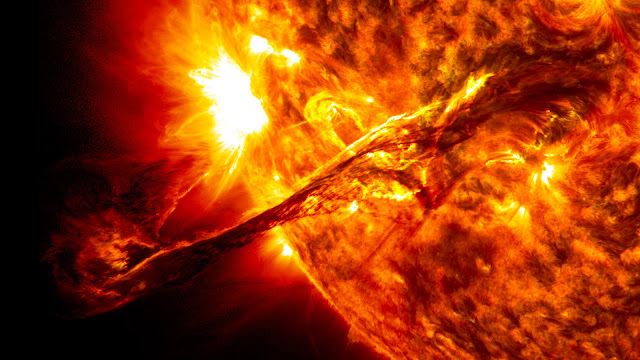NASA - Solar Dynamics Observatory (SDO) patch.
April 26, 2017
From long, tapered jets to massive explosions of solar material and energy, eruptions on the sun come in many shapes and sizes. Since they erupt at such vastly different scales, jets and the massive clouds — called coronal mass ejections, or CMEs — were previously thought to be driven by different processes.
Scientists from Durham University in the United Kingdom and NASA now propose that a universal mechanism can explain the whole spectrum of solar eruptions. They used 3-D computer simulations to demonstrate that a variety of eruptions can theoretically be thought of as the same kind of event, only in different sizes and manifested in different ways. Their work is summarized in a paper published in Nature on April 26, 2017.
A Solar Eruption in 5 Steps
Video above: Follow the evolution of a jet eruption in this video, which uses a 3-D computer simulation of the breakout model to demonstrate how a filament forms, gains energy and erupts from the sun. Video Credits: NASA’s Goddard Space Flight Center/ARMS/Genna Duberstein, producer.
The study was motivated by high-resolution observations of filaments from NASA’s Solar Dynamics Observatory, or SDO, and the joint Japan Aerospace Exploration Agency/NASA Hinode satellite. Filaments are dark, serpentine structures that are suspended above the sun’s surface and consist of dense, cold solar material. The onset of CME eruptions had long been known to be associated with filaments, but improved observations have recently shown that jets have similar filament-like structures before eruption too. So the scientists set out to see if they could get their computer simulations to link filaments to jet eruptions as well.
“In CMEs, filaments are large, and when they become unstable, they erupt,” said Peter Wyper, a solar physicist at Durham University and the lead author of the study. “Recent observations have shown the same thing may be happening in smaller events such as coronal jets. Our theoretical model shows the jet can essentially be described as a mini-CME.”
Solar scientists can use computer models like this to help round out their understanding of the observations they see through space telescopes. The models can be used to test different theories, essentially creating simulated experiments that cannot, of course, be performed on an actual star in real life.
Image above: A long filament erupted on the sun on Aug. 31, 2012, shown here in imagery captured by NASA's Solar Dynamics Observatory. Image Credits: NASA's Goddard Space Flight Center/SDO.
The scientists call their proposed mechanism for how these filaments lead to eruptions the breakout model, for the way the stressed filament pushes relentlessly at — and ultimately breaks through — its magnetic restraints into space. They previously used this model to describe CMEs; in this study, the scientists adapted the model to smaller events and were able to reproduce jets in the computer simulations that match the SDO and Hinode observations. Such simulations provide additional confirmation to support the observations that first suggested coronal jets and CMEs are caused in the same way.
“The breakout model unifies our picture of what’s going on at the sun,” said Richard DeVore, a co-author of the study and solar physicist at NASA’s Goddard Space Flight Center in Greenbelt, Maryland. “Within a unified context, we can advance understanding of how these eruptions are started, how to predict them and how to better understand their consequences.”
The key for understanding a solar eruption, according to Wyper, is recognizing how the filament system loses equilibrium, which triggers eruption. In the breakout model, the culprit is magnetic reconnection — a process in which magnetic field lines come together and explosively realign into a new configuration.
In stable conditions, loops of magnetic field lines hold the filament down and suppress eruption. But the filament naturally wants to expand outward, which stresses its magnetic surroundings over time and eventually initiates magnetic reconnection. The process explosively releases the energy stored in the filament, which breaks out from the sun’s surface and is ejected into space.
NASA’s Solar Dynamics Observatory (SDO). Image Credit: NASA
Exactly which kind of eruption occurs depends on the initial strength and configuration of the magnetic field lines containing the filament. In a CME, field lines form closed loops completely surrounding the filament, so a bubble-shaped cloud ultimately bursts from the sun. In jets, nearby fields lines stream freely from the surface into interplanetary space, so solar material from the filament flows out along those reconnected lines away from the sun.
“Now we have the possibility to explain a continuum of eruptions through the same process,” Wyper said. “With this mechanism, we can understand the similarities between small jets and massive CMEs, and infer eruptions anywhere in between.”
Confirming this theoretical mechanism will require high-resolution observations of the magnetic field and plasma flows in the solar atmosphere, especially around the sun’s poles where many jets originate — and that’s data that currently are not available. For now, scientists look to upcoming missions such as NASA’s Solar Probe Plus and the joint ESA (European Space Agency)/NASA Solar Orbiter, which will acquire novel measurements of the sun’s atmosphere and magnetic fields emanating from solar eruptions.
Related links:
Article on Nature April 26, 2017: http://nature.com/articles/doi:10.1038/nature22050
NASA’s Solar Dynamics Observatory (SDO): https://www.nasa.gov/mission_pages/sdo/overview/index.html
NASA’s Solar Probe Plus: https://science.nasa.gov/missions/solar-probe
ESA (European Space Agency)/NASA Solar Orbiter: https://science.nasa.gov/missions/solar-orbiter
Hinode (Solar B): http://www.nasa.gov/mission_pages/hinode/index.html
Space Weather: https://www.nasa.gov/subject/3165/space-weather
Images (mentioned), Video (NASA), Text, Credits: NASA’s Goddard Space Flight Center, by Lina Tran/Rob Garner.
Greetings, Orbiter.ch



